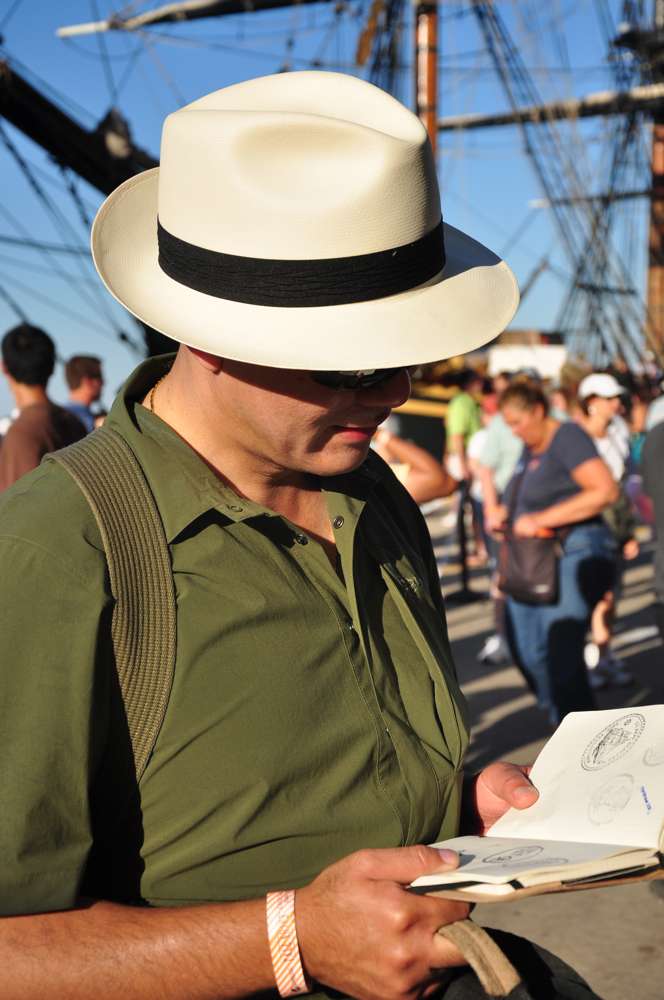I found this interesting reading as I have been contemplating purchasing a straw hat. Please indulge me as I post the following information from:
http://www.cowboyhatinfo.org/shantung_hats.html
"Since the first use of Shantung (aka Shantung Panama) to make hats, the material remains widely a mystery. Many people believe that shantung hats are made of natural straw. It is actually made out of a high performance paper which is rolled into a yarn to imitate straw. Furthermore, many people believe that shantung paper yarn is made out of rice paper. Rice paper is actually a misnomer. Currently, there are no papers being made out of rice. Although, for the size papers made out of Kozo, Gampi and Mitsumata, rice starch was traditionally used. (This is probabaly where the name "rice paper" comes from.) Kozo, Gampi and Mitsumata were originally used to make the high performance paper. The paper was named "Washi" by the Japanese who perfected the technique in 610 AD after Korean Buddhist monks learned the Chinese technique and introduced it to Japan. (The Chinese invented the technique of making this paper during the first century.)
Washi literally meaning "Japanese Paper," became famous worldwide for it's unique characteristics. Washi is thinner and lighter in weight yet stronger than any other paper. In recent years, because of quantity, availability, and tensile strength, washi is now mainly being produced with the Manila Hemp plant. (Musa Textilis, Abaca) The Manila Hemp plant is native to the Philippine Islands, but it can also be found in other parts of the world. (ie. Central America, Indonesia, Australia, Borneo, etc.) The majority of the world's production still remains largely in the Philippine Islands.
In the mid-1900's, natural panama straw became scarce and hat manufacturer were in desperate need of finding a replacement. Washi was then introduced as an alternative and was perfect for making hats. Wanting a better name for the hat industry, "Washi" was renamed to "Shantung Panama". It quickly became widely accepted because of its similarity in looks to the natural panama straw. It was also very durable, light weight, and cost effective. Today, cowboy hat manufacturers mainly use shantung to make hats. Shantung hats now command more than 65% of the hat market."
http://www.cowboyhatinfo.org/shantung_hats.html
"Since the first use of Shantung (aka Shantung Panama) to make hats, the material remains widely a mystery. Many people believe that shantung hats are made of natural straw. It is actually made out of a high performance paper which is rolled into a yarn to imitate straw. Furthermore, many people believe that shantung paper yarn is made out of rice paper. Rice paper is actually a misnomer. Currently, there are no papers being made out of rice. Although, for the size papers made out of Kozo, Gampi and Mitsumata, rice starch was traditionally used. (This is probabaly where the name "rice paper" comes from.) Kozo, Gampi and Mitsumata were originally used to make the high performance paper. The paper was named "Washi" by the Japanese who perfected the technique in 610 AD after Korean Buddhist monks learned the Chinese technique and introduced it to Japan. (The Chinese invented the technique of making this paper during the first century.)
Washi literally meaning "Japanese Paper," became famous worldwide for it's unique characteristics. Washi is thinner and lighter in weight yet stronger than any other paper. In recent years, because of quantity, availability, and tensile strength, washi is now mainly being produced with the Manila Hemp plant. (Musa Textilis, Abaca) The Manila Hemp plant is native to the Philippine Islands, but it can also be found in other parts of the world. (ie. Central America, Indonesia, Australia, Borneo, etc.) The majority of the world's production still remains largely in the Philippine Islands.
In the mid-1900's, natural panama straw became scarce and hat manufacturer were in desperate need of finding a replacement. Washi was then introduced as an alternative and was perfect for making hats. Wanting a better name for the hat industry, "Washi" was renamed to "Shantung Panama". It quickly became widely accepted because of its similarity in looks to the natural panama straw. It was also very durable, light weight, and cost effective. Today, cowboy hat manufacturers mainly use shantung to make hats. Shantung hats now command more than 65% of the hat market."





